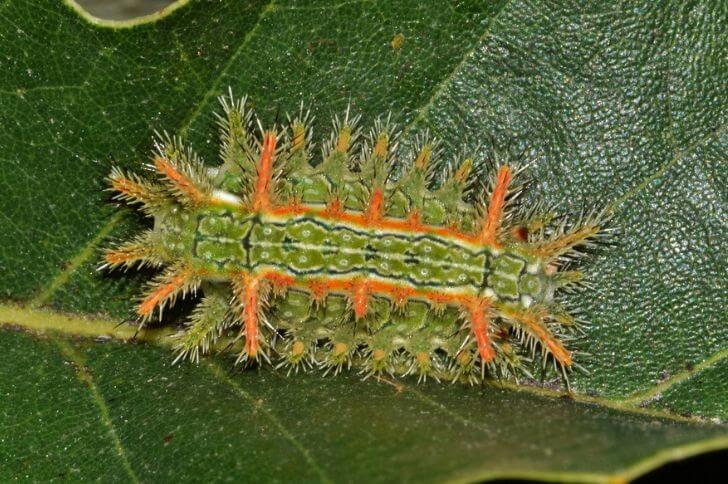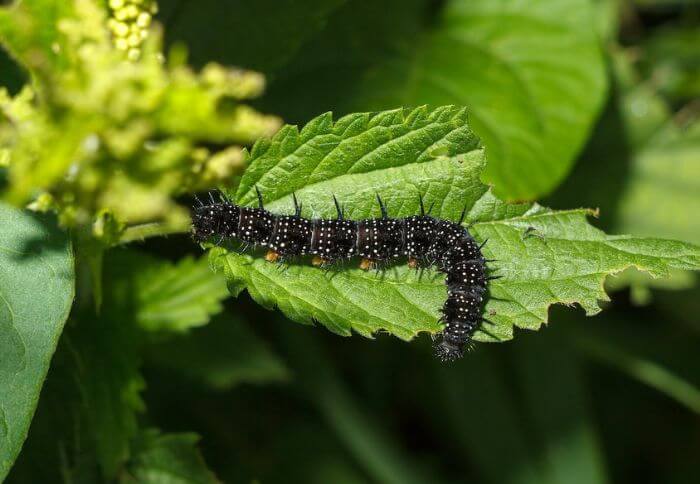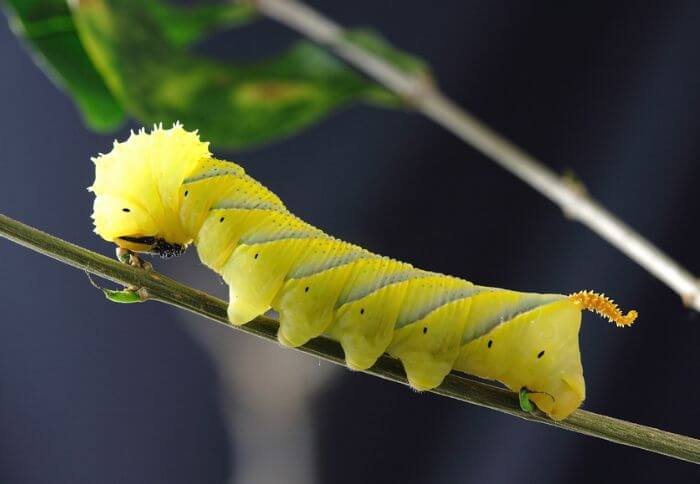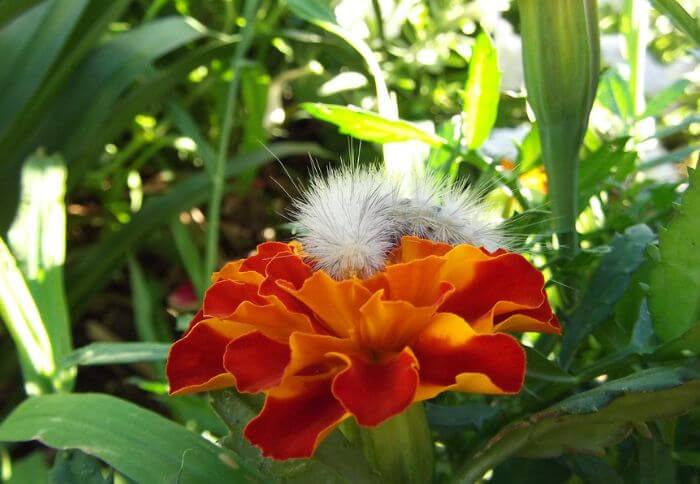13 Black Fuzzy Caterpillars (ID & Identification)
Caterpillars, with their remarkable ability to transform into moths or beautiful butterflies, have long captivated the curiosity of nature enthusiasts. Among these fascinating creatures are the black fuzzy caterpillars, a diverse group that showcases an array of captivating features and behaviors.
With their velvety appearance and eye-catching patterns, these mysterious critters stand out among their fellow caterpillar counterparts. From the salt marsh moth caterpillar to the enchanting woolly bear caterpillar, each species possesses its own unique set of characteristics that make them truly intriguing.
Join us as we delve into the world of black fuzzy caterpillars and uncover the astonishing diversity within this enchanting group of insects.
List of Black Fuzzy Caterpillars
1. Salt Marsh Moth Caterpillar (Estigmene acrea)
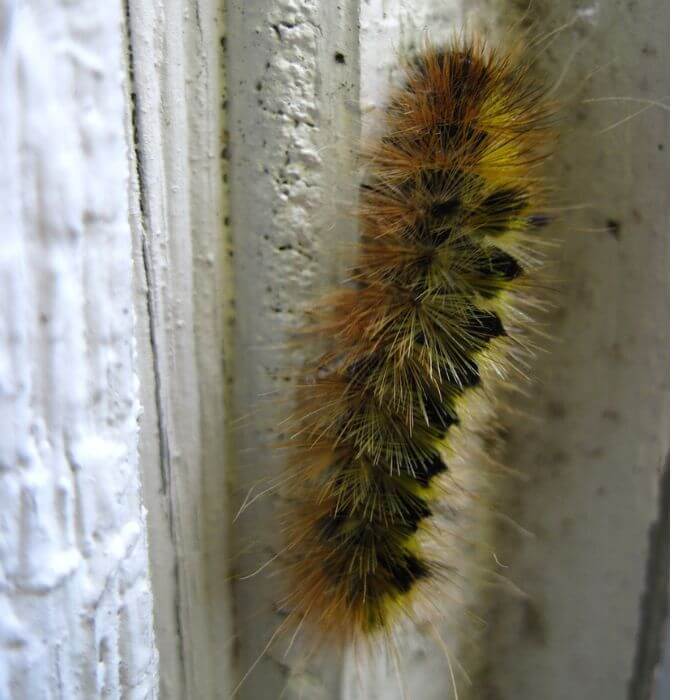
The salt marsh caterpillar is a fascinating creature that captivates with its black fuzzy exterior. Found mostly in Texas and Florida, this species has become a favorite subject of curiosity among nature enthusiasts and researchers alike.
Despite its small size, about 2 inches, this caterpillar exhibits an array of intriguing behaviors that make it stand out from other species.
One unique characteristic of this caterpillar is its ability to change color as it progresses through different instar stages. When newly hatched, these caterpillars display a striking orange coloration that gradually transforms into black with white lateral stripes as they grow.
This color transition is believed to serve as a form of camouflage against predators, allowing them to blend in with their surroundings and ensure their survival.
2. Woolly Bear Moth Caterpillar (Pyrrharctia Isabella)
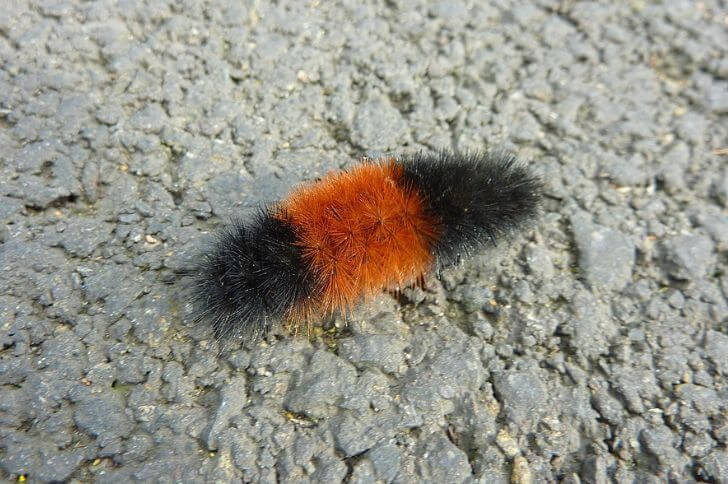
Woolly bears are not your ordinary black hairy critters. These striking larvae sport a vibrant combination of black and reddish-orange hairs that capture our attention from the moment we lay eyes on them.
Their unique appearance has earned them a special place in folklore, with many believing that these caterpillars can predict the severity of the upcoming winter.
But there’s more to these cuddly-looking creatures than meets the eye. The distinguishing feature of woolly bear caterpillars is their ability to survive through freezing temperatures.
While other insects would succumb to the bitter cold, these resilient creatures produce a natural antifreeze-like substance called glycerol, which prevents ice crystals from forming and damaging their cells.
This remarkable adaptation allows them to hibernate during harsh winters and resume their journey towards adulthood when spring arrives.
3. Mourning Cloak Butterfly Caterpillar (Nymphalis antiopa)
Boasting a lifespan of up to 12 months, the mourning cloak butterfly is one of the most remarkable butterflies in North America and its caterpillar is equally remarkable.
With its long black body adorned with long and short spines, it stands out among other caterpillars in both appearance and behavior. But what makes this particular caterpillar so fascinating is the red spots on its back which makes it easily identifiable from other types of hairy caterpillars.
During this caterpillar stage, this species consumes large amounts of leaves of willows, wild roses, hackberries and elms.
4. Harnessed Tiger Moth Caterpillar
One of the most fascinating caterpillars you might encounter in the wild is the harnessed tiger moth caterpillar. With its beautifully patterned black and yellow stripes, this caterpillar never fails to capture attention. But that’s not all that makes it so captivating.
Ranging from Maine to Florida and South Dakota, this black fuzzy caterpillar sources its food from clovers, plantains, corn and dandelion. Note; these non-poisonous caterpillars have a huge appetite, consuming up to 2000 times its body weight.
When the transformation process is complete, this caterpillar becomes a large tiger moth caterpillar.
5. Giant Leopard Moth Caterpillar

One of the most intriguing and visually striking caterpillars you may come across is the giant leopard moth caterpillar. With its vibrant black and red ring pattern, it is unmistakable in appearance.
Also, these caterpillars are known for their nomadic lifestyle, often moving around to find the best feeding grounds. They are usually found munching on plants like dandelions, cabbage and sunflowers.
What makes them even more fascinating is their ability to curl up into a ring when they feel threatened – a defense mechanism that helps them look larger and protects their soft underside.
6. Silvery Checkerspot Caterpillar (Chlosyne nycteis)
The silvery checkerspot caterpillar is a striking and captivating creature that catches the eye with its unique appearance.
With a black fuzzy body and rows of bright orange or yellow stripes along its sides, this caterpillar is truly a sight to behold. It can often be found munching on various plants such as sunflowers, asters, and wingstems.
But beyond its aesthetic appeal, the silvery checkerspot caterpillar has some fascinating attributes that set it apart from other caterpillars.
One notable characteristic is its defensive mechanism called crypsis, which helps it blend seamlessly into its surroundings by resembling bird droppings. This clever camouflage tricks predators into thinking they’re looking at something not worth eating.
As this black hairy caterpillar grows and matures, it undergoes several molting stages before finally transforming into a chrysalis. During these stages of growth, it sheds its skin multiple times to accommodate its increasing size.
Once fully developed inside the chrysalis, this remarkable transformation culminates in an emergence of vibrant colors as an adult butterfly ready to take to the skies.
7. Julia Butterfly Caterpillar (Dryas iulia)
Another type of black intriguing caterpillar found in nature is the Dryas iulia caterpillar, commonly known as the Julia heliconian butterfly caterpillar.
This striking creature sports a vibrant black body covered in long, sharp black spines, creating a captivating contrast against its bright orange ‘legs’.
It’s commonly found in South America, Texas and parts of Florida. And, unlike other black fuzzy caterpillars,, the julia butterfly caterpillar almost exclusively feeds on passion fruit leaves.
This means it’s limited to certain regions where this plant thrives. The julia butterfly does not migrate. Are julia butterfly caterpillars poisonous? No, but their sharp spines do cause irritation when touched. So if you come across this black spiky caterpillar, avoid touching it.
8. Yellow-spotted Tussock Moth Caterpillar (Lophocampa maculata)
No list of black fuzzy caterpillars would be complete without mentioning the yellow-spotted tussock moth caterpillar. Its body is covered in soft yellow and black hairs that give it a fuzzy appearance.
Also note the long white hairs that stick on the front and back of its body. Like other tussock moth caterpillars, this species mostly feeds on willows and poplars. It will also consume leaves of oaks and maples.
When do tussock moth caterpillars pupate? When they are around two months old they pupate, forming brown cocoons where they hibernate throughout winter. Note, these little critters are not poisonous.
9. Red Admiral Caterpillar
With its bold black body with vibrant red markings, the red admiral butterfly is a true showstopper. Its equally unique caterpillar can be found on stinging nettle plants, where it feeds voraciously, growing rapidly in size.
Also, like other black fuzzy caterpillars on this list, it undergoes a transformation process. As it sheds its old skin and grows a new one, the caterpillar’s colors become darker and intense, making it easy to spot against green foliage.
10. Garden Tiger Moth Caterpillar
Spotting orange and black hairs, the garden tiger moth caterpillar is a fascinating little creature that is frequently spotted in many gardens around the world. With its unique coloration, it is hard to miss this striking caterpillar.
Like most black fuzzy caterpillars, the garden tiger moth caterpillars do consume a lot of plant matter at this stage. However, these caterpillars have a unique diet in that they prefer toxic plants such as foxgloves.
Leaves from these toxic plants help them develop a defense system against humans and animals. When touched, both butterflies and caterpillars of this species release toxins that cause irritation.
11. Jute Hairy Caterpillar (Spilosoma obliqua)
Found in parts of Asia, the jute hairy moth is truly a sight to behold. Its vibrant orange color and black spots give it a butterfly-look. Most people mistake this hairy moth for a butterfly.
During the caterpillar stage, this species has a black and fuzzy front and back and a bright orange middle. And unlike the giant leopard moth caterpillars, their hairs are sparsely distributed.
Despite their ominous appearance, these black hair caterpillars are harmless and play a vital role in the ecosystem. Another reason to watch these caterpillars is their feeding habits.
They have a voracious appetite and can devour vast quantities of leaves from various plants. This makes them important contributors to the cycling of organic matter in ecosystems where they reside.
12. Eastern Tent Caterpillar
One particular species of black fuzzy caterpillar that is often seen crawling on the branches of trees in Eastern North America is the eastern tent caterpillar.
Unlike some other caterpillars, the eastern tent caterpillar is known for its distinct behavior of constructing large silk tents in the crotches of tree branches during their early stages of development.
These tents not only provide protection from predators but also serve as a gathering place for hundreds of these creatures to rest and molt.
Although they may appear harmless, eastern tent caterpillars can actually be quite destructive to trees if their populations grow too large. Their voracious appetite for foliage can defoliate entire branches or even entire trees within a short period.
13. Creatonotos Gangis Moth Caterpillar
One of the most weird looking moths of Australia is the Creatonotos gangis. With its orange-red abdomen, brown and black wings and 4 long tentacles, this moth is a sight to behold.
The caterpillar is also intriguing. With its black fuzzy body, yellow stripe and orange spots, this caterpillar stands out among its peers.
And the creatonotos ganging caterpillar is considered a pest. It feeds on rice, groundnuts, sweet potato and coffee plant leaves.
14. Crimson Tiger Moth Caterpillar (Ardices curvata)
While there are countless species of caterpillars out there, the crimson tiger moth caterpillar stands out with its distinctive black and fuzzy appearance.
Native to Australia, this caterpillar’s striking coloration serves as a warning to predators that it is not to be messed with. Its black spiky hairs act as a defense mechanism against potential threats, causing irritation and discomfort upon contact.
This unique adaptation allows the crimson tiger moth caterpillar to ward off most predators, keeping it safe throughout its life cycle.
One interesting aspect of this particular caterpillar is its feeding habits. It has a voracious appetite for plants, particularly common beans and dandelions.
The lifecycle of this black hairy caterpillar is also worth mentioning. After hatching from their tiny eggs laid on host plants by adult moths, these larvae undergo several stages of growth before reaching adulthood.
Throughout their development, they molt several times shedding old skin to accommodate their increasing size until they finally form pupae within cocoons. The transformation takes place inside these protective structures over a period ranging from weeks to months depending on environmental conditions such as temperature and humidity levels.
Final Thoughts:
In conclusion, there are several types of black fuzzy caterpillars that can be found in various regions. These caterpillars not only vary in appearance but also in their behavior and feeding habits.
While some may be harmless and beneficial to the environment, others can pose a threat to plants and crops. Therefore, it is important to identify these caterpillars correctly to determine the appropriate actions that need to be taken.
By understanding the different types and their characteristics, we can better appreciate the diversity of nature and ensure the balance of ecosystems. So next time you come across a black fuzzy caterpillar, take a moment to observe and appreciate its unique qualities before deciding on how best to interact with it.
sources:
https://en.wikipedia.org/wiki/Giant_leopard_moth
https://frontiersinzoology.biomedcentral.com/articles/10.1186/s12983-019-0345-6

Passionate animal enthusiast and skilled writer with a flair for captivating storytelling. With over five years of experience, I have crafted engaging content that sheds light on the fascinating world of animals.
Through my articles, blog posts, and social media campaigns, I strive to raise awareness about conservation efforts and promote a deeper understanding of the natural world.
